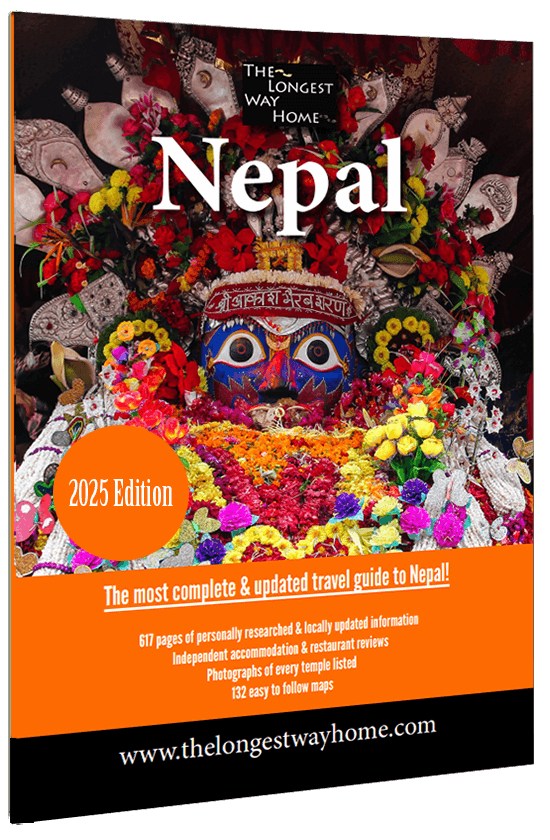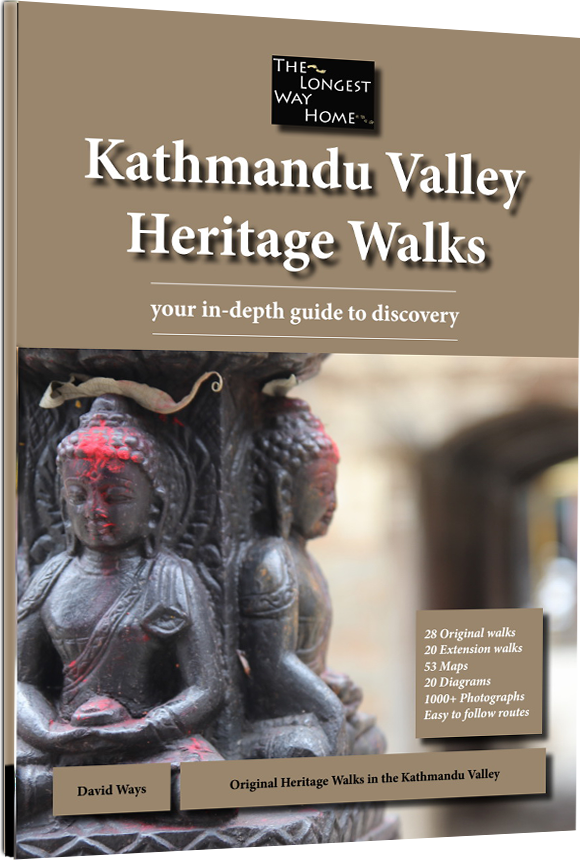About the Kathesimbhu stupa
Located between Thamel and Kathmandu Durbar Square in the heart of Kathmandu city, Nepal. The Kathesimbhu stupa is a 17th century copy of the famous Swayambhunath Stupa. Indeed Kathesimbhu means "Kathmandu Swayambhunath." It is also less commonly known as Srigha Chaitya or Sigha Chaitya.

Moreover it's believed that Kathesimbhu was built from the materials left over from Swayambhunath. As such it's used for the old or infirmed who cannot make the journey to Swayambhunath on a pilgrimage.
The Kathesimbhu stupa is technically a monumental chaitya which stands within a closed off courtyard surrounded by smaller chaityas inscriptions, statutes and an old monastery (Sighahbaha) located directly behind. To the right is a more modern Tibetan style monastery.
Within the courtyard is one Avalokiteshvara statue predates the stupa much further than the 17th century. A drawing in 1864 (Wright) shows Kathesimbhu in ruins, but with similar architecture as today. The earliest known records of Kathesimbhu are mentions in 1552 which mention a renovation. Licchavi chaitya are represented here which gives a clearer indication of the location dating back to at least 700 CE.
There are several stalls nearby and vendors will often try to encourage you to visit their stores.
Did you know?
There are several other buildings within the Kathesimbhu square worth exploring. Including the large Tibetan Monastery known as Shree Ghah Gumba.
Although the Kathesimbhu is popularly quoted as being constructed in 1650 CE there is evidence that states it originally was built during the late Licchavi period in the 8th century. The Kathesimbhu stupa was built as a substitute tirtha (pilgrimage site) for those unable to make it to Swayambhunath stupa.

There's a legend that gives a different story on the construction of the Kathesimbhu stupa. It says that a stupa was built in the Indian city of Benares. To consecrate it the revered Vakvajara from Nepal was sent for.
Vakvajara consecrated the stupa with some drops from the Benares river. However the people of Benares were not satisfied with such a simple ceremony who thereafter had little fate in the stupa.
Vakvajra tried to move the stupa but this failed. Vakvajra then performed a mantra and the stupa moved by itself all the way back to Nepal where it became known as what is today - the Kathesimbhu stupa.
Around the Kathesimbhu stupa
There's an eclectic collection of small stone votive chaitya and larger mahachaityas around the Kathesimbhu courtyard but most are largely 20th century additions. However the painted domed chaitya are rumored to be from the 5th and 6th centuries which links to the stupas claims of being older than the 17th century. Some small chaitya have been brightly painted which may match their original color scheme.

Shree Ghah Gumba:
The Tibetan style monastery Shree Ghah Gumba stands near the main chaitya which you are also free to visit. It's colorful decor and golden gates stand out from the otherwise Newari style courtyard design.
Hariti Shrine:
To the rear on the northern side of the courtyard stands a small metal fenced in two-storey pagoda dedicated to Hariti, the goddess of smallpox. You can visit a more open shrine to Hariti in Boudha or indeed Swayambhu.
Surrounding the courtyard is Dharma Kirti Bhihar and opposite this and the stupa is Sigha Bahal In the south west corner is another shrine to Buddha.
Entrance fee for the Kathesimbhu stupa
There is currently no entrance fee for the Kathesimbhu stupa. However that could change as local entrepreneurs try to raise funds.
Directions to the Kathesimbhu stupa
By walking: The Kathesimbhu stupa is about 10min from Thamel in Kathmandu or 15 minutes from Durbar Square. It's a pleasant walk with many small side streets and stores along the way.
The biggest problem is that none of the streets are named well. It's best visited on a heritage walk on the way to Kathmandu Durbar Square. Kathesimbhu is located just south of Thahiti Chowk and is relatively easy to find.
By taxi: It's not worth it. The streets are too narrow and the crowds will only slow you down. If you can translate the Kathesimbhu stupa to a cycle rickshaw you'll stand a better chance. Walking to Kathesimbhu stupa is the best option.
Heritage walk guide:
» Kathmandu Heritage Walks
- Thamel Heritage Walk
- Thahiti Chowk
- Ason Chowk
- Jana Bahal / Seto Machchhendranath
- Indra Chowk
- Kathmandu Durbar Square
Get my Guidebooks for the best in heritage walks!
Liked this page? You'll love my books!
100% independent guidebooks, with no sponsored trips or ads. Designed to help travelers get the most out their trip to Nepal with premium detailed guides, insider information, impartial hotel and restaurant reviews, complete trekking routes, dedicated heritage walks & much more ...
Available in print or digital editions - the best guidebooks for visiting Nepal.
 |
 |
Full Nepal Guidebook
|
Kathmandu Valley Heritage Walks
|
Was this page helpful to you? If so please tell others!


